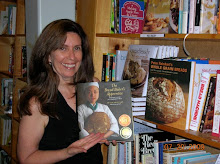 The French Bread
The French BreadMany years ago, I was baking several breads from Bernard Clayton's wonderful tome, The Complete Book of Breads. During this time, Mr. Clayton (the Peter Reinhart of his time) returned from an extended journey throughout France, where he visited countless bread bakers learning their trade secrets. The outcome of this journey was the publication of his great masterpiece, The Breads of France. I baked several different versions of our beloved French bread during those years, finally choosing one to call my own. It was Monsieur Monfort's French bread, and I believe it was from the Complete Book of Breads.
I made this bread so many times over the years I have long since lost count. I became somewhat famous, at least among my family and friends. In fact, my then sisters-in-law said that I was making them look bad by having this amazing bread coming out of my oven on a regular basis. My two children grew up on this bread, and it is as much a part of their childhood memories as their favorite books and toys.
When I read that this challenge would include a French bread, I sniffed with disdain. Why would I need to make this, I wondered, when I already had perfected this fabulous formula?
I am happy to say that I was wrong. When this bread came out of the oven, with its deep, golden-hued crust, it literally crackled as it met the cool air outside of the blast-furnace oven temperature of 500 degrees. And the flavor is far and away superior to my previous formula. I think it is the extra step of making the pre-ferment. It gives just a hint of added flavor without it tasting like sourdough. Not that there's anything at all wrong with that tart, pungent quality in a good sourdouch loaf, but that is not French bread, whereas this is.
This was so amazing that I made it again for my birthday party in November. At first my daughter, who grew up eating the now iconic Monsieur Monfort's bread, was skeptical. "Nothing could be as good as your 'old' French bread, Mom." Later, though, she changed her mind, reluctantly agreeing that this current formula yielded a superior loaf. Everyone at the party concurred, and even though they all know about this project of mine, they were still amazed at this fantastic bread.

Here I am with my daughter, Cate, at my birthday party.

Dough - Ready for Shaping
 Pinching the seam of the underside of the baguette helps to seal it.
Pinching the seam of the underside of the baguette helps to seal it.
 The formed baguettes before rising.
The formed baguettes before rising.

The Risen Loaves Ready for the Oven

In the Oven

The Trio of Baguettes
Look at that crackling, golden crust!
















